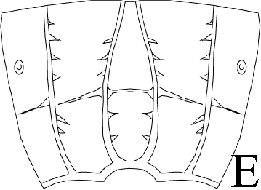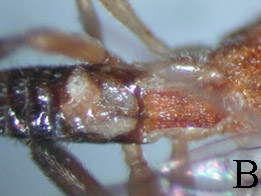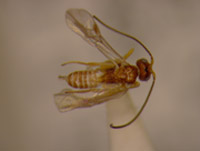Mendesellinae
Alejandro A. Valerio- Epsilogaster Whitfield & Mason 1994
- Epsilogaster panama
- Epsilogaster tico
- Epsilogaster durero
- Epsilogaster braziliensis
- Epsilogaster fabiolae
- Epsilogaster antoniae
- Epsilogaster palenque
- Epsilogaster bicolor
- Mendesella Whitfield & Mason 1994
- Mendesella magna
- Mendesella braziliensis
- Mendesella amazonica
- Mendesella orianae
Introduction
This rarely collected Neotropical group of braconid wasps (Fig. 4) is one of the latest additions at the subfamily level (Whitfield and Mason 1994). The subfamily was discovered originally by W.R.M. Mason at the Canadian National Insect Collection (Ottawa, Canada), but Mason’s sudden death in 1991 postponed the description of this taxon until J. B. Whitfield was able to complete the descriptions of two genera and nine species.
Unfortunately, the biology of the group is still poorly known. To date, there is only one host record, for Epsilogaster bicolor Whitfield & Mason, which parasitizes a momphid stem galler on Cephalanthus occidentalis L. (commonly known as buttonbush). In recent years, a wave of newly discovered species have produced a better understanding of the species composition and distribution of the Mendesellinae; however, there seems to be a great deal of biological information and unknown species yet to be discovered.



Figure 4. Geographical distribution for the known species of the genus Epsilogaster (A) and Mendesella (B) (Braconidae: Mendesellinae). The numbers on the figure represents the number of species by country of locality. Images copyright© 2006 Alejandro A. Valerio.
Characteristics
This subfamily is characterized by the location of the first metasomal spiracle on the medial tergite (as opposed to being separated on a laterotergite as in other microgastroids), possession of finely striate membranous laterotergal areas (Fig. 5C), and areas of scelerotization on the second and third terga. The propodeum exhibits four subparallel longitudinal carinae (Fig. 5E). In addition, the mendesellines have distinctive wing venation (Fig. 5B). Whitfield and Mason (1994) also mention the very large and setose compound eyes and the large tentorial pits (Fig. 5A).
Classification
The taxon Mendesellinae is divided into two genera: Epsilogaster and Mendesella (Whitfield and Mason 1994). This division is mainly based on the presence of an “E” shaped sclerotized structure on the second metasomal tergum, a posteriorly narrowed first metasomal tergum, and a truncate or emarginate hypopygium in the genus Epsilogaster (Epsilogaster means E shaped) (Fig. 5D). In contrast, the genus Mendesella (named after the union and environmental activist Francisco Alves "Chico" Mendes) is characterized by the apically broader first metasomal tergum and apically acute hypopygium with a typically sinuate ovipositor.






Figure.5. Epsilogaster antoniae Valerio & Whitfield face in frontal view (arrow points to tentorial pits) (A); E. panama Whitfield & Mason first metasomal tergum (C) ovipositor in lateral view (D); E. fabiolae Valerio & Whitfield wing venation (B) and E. palenque Whitfield & Mason propodeum (modified after Whitfield & Mason 1994)(E). Images copyright © 2006 Alejandro A. Valerio, except for 5C and 5D by Rodriguez & Whitfield © 2006.


Figure 6. First metasomal tergum (dorsal view) of Epsilogaster bicolor Whitfield & Mason (A) and Mendesella orianae Valerio & Whitfield (B). Images copyright © 2006 Alejandro A. Valerio.
Phylogenetic Position of Mendesellinae
The subfamily Mendesellinae is included within the ‘microgastroid’ assemblage of braconid subfamilies; this assemblage of taxa basically represents the ‘Microgastri’ sensu Mason (1983) plus the subfamily Mendesellinae (Fig. 7). The Mendesellinae are the most basal lineage based on the morphological analysis by Whitfield and Mason (1994). In most recet years Banks and Whitfield (2006) have supported this phylogenetic placement using molecular phylogenetic analysis of seven genes.
So far the subfamily Mendesellinae has been established to be a monophyletic group using morphological characters as well as molecular markers (Whitfield & Mason 1994; Banks & Whitfield 2006); in a similar way the two genera within the Mendesellinae are also thought to be monophyletic as well.
Identification Guides
The manual for the New World Genera of family Braconidae (Wharton et al. 1997) can be used for the identification of genera. There are also online versions of these keys. Additionally, Pitz (2004) and Yamada & Panteado-Dias (2002) have the most recent species keys for the genera Epsilogaster and Mendesella respectively.
References
Banks, J.C. and J.B. Whitfield. 2006. Dissecting the ancient rapid radiation of microgastrine wasp genera using additional nuclear genes Molecular Phylogenetics and Evolution (in press).
Figueroa-De la Rosa, J.I., Valerio, A.A., López M., V., Whitfield, J. B. and M. J. Sharkey. 2004. Descriptions of two new species of Epsilogaster Whitfield &Mason (Hymenoptera: Braconidae) from Mexico and Costa Rica. Pan-Pacific Entomologist 79(3): 198-206.
Mason, W.R.M. 1983. A new South African subfamily related to Cardiochilinae (Hymenoptera: Braconidae). Contributions of the American Entomological Institute 20: 49-62.
Pitz, K.M. 2004. Epsilogaster fullertoni, a new species of Epsilogaster Whitfield and Mason (Hymenoptera: Braconidae: Mendesellinae) from Florida, USA. Zootaxa 716: 1-7.
Valerio, A.A. 2006. Sobre el estado actual de la taxonomía y filogenia de la subfamilia Mendesellinae (Hymenoptera, Braconidae). Métodos en Ecología y Sistemática (MES) 2(1):10-15. Available online
Valerio, A.A. and J.B. Whitfield. 2002. Epsilogaster faviolae, a new species of Mendesellinae from Colombia (Hymenoptera: Braconidae). Zootaxa 41: 1-7.
Valerio, A.A. and J.B. Whitfield. 2000. Taxonomic Notes on Costa Rican Mendesellinae (Ichneumonoidea: Braconidae), with description of a New Central American Species of Mendesella. Journal of Hymenoptera Research 9(2): 271-276.
Wharton, R.A., Marsh, P.M. and M.J. Sharkey, eds. 1997. Manual of the New World genera of the family Braconidae (Hymenoptera). International Society of Hymenopterist. Spec. Pub. No. 1.
Whitfield, J.B. and W.R.M. Mason. 1994. Mendesellinae, a new subfamily of braconid wasps (Hymenoptera, Braconidae) with a review of relationships within the microgastroid assemblage. Systematic Entomology 19: 61-76.
Yamada, M.V. and A.M. Panteado. 2002. Mendesella jaraguensis, a new species of mendeseline wasp (Hymenoptera: Braconidae) from Brazil. Entomological News 113(4): 236-238.
Title Illustrations

About This Page
Work on the Mendesellinae Tree of Life web page was supported by the Central American Institute for Biological Research and Conservation.
The author wants to thank Prof. J. B. Whitfield (University of Illinois at Urbana-Champaign), Josephine Rodriguez (University of Illinois at Urbana-Champaign) and Jessica A. Diaz, for their valuable comments during the development of this webpage. Also I like to thank the Instituto Nacional de Biodiversidad (INBio) for allowing me to use and photograph the mendeselline material, especially to Ronald Zuñiga y Manuel A. Solis. Also I would like to thank Scott "Dude" Robinson at the Beckman Institute (University of Illinois at Urbana-Champaign) for his help during the E.S.E.M. session for the E. panama pictures.
For more information about Chico Mendes visit: http://www.chicomendes.org.br

Centralamerican Institute for Biological Research and Conservation (CIBRC), Costa Rica
Correspondence regarding this page should be directed to Alejandro A. Valerio at
Page copyright © 2007
All Rights Reserved.
- First online 04 February 2007
- Content changed 04 February 2007
Citing this page:
Valerio, Alejandro A. 2007. Mendesellinae . Version 04 February 2007 (under construction). http://tolweb.org/Mendesellinae/23456/2007.02.04 in The Tree of Life Web Project, http://tolweb.org/













 Go to quick links
Go to quick search
Go to navigation for this section of the ToL site
Go to detailed links for the ToL site
Go to quick links
Go to quick search
Go to navigation for this section of the ToL site
Go to detailed links for the ToL site